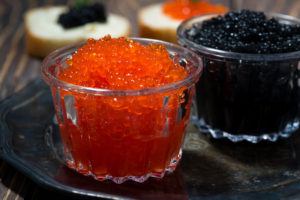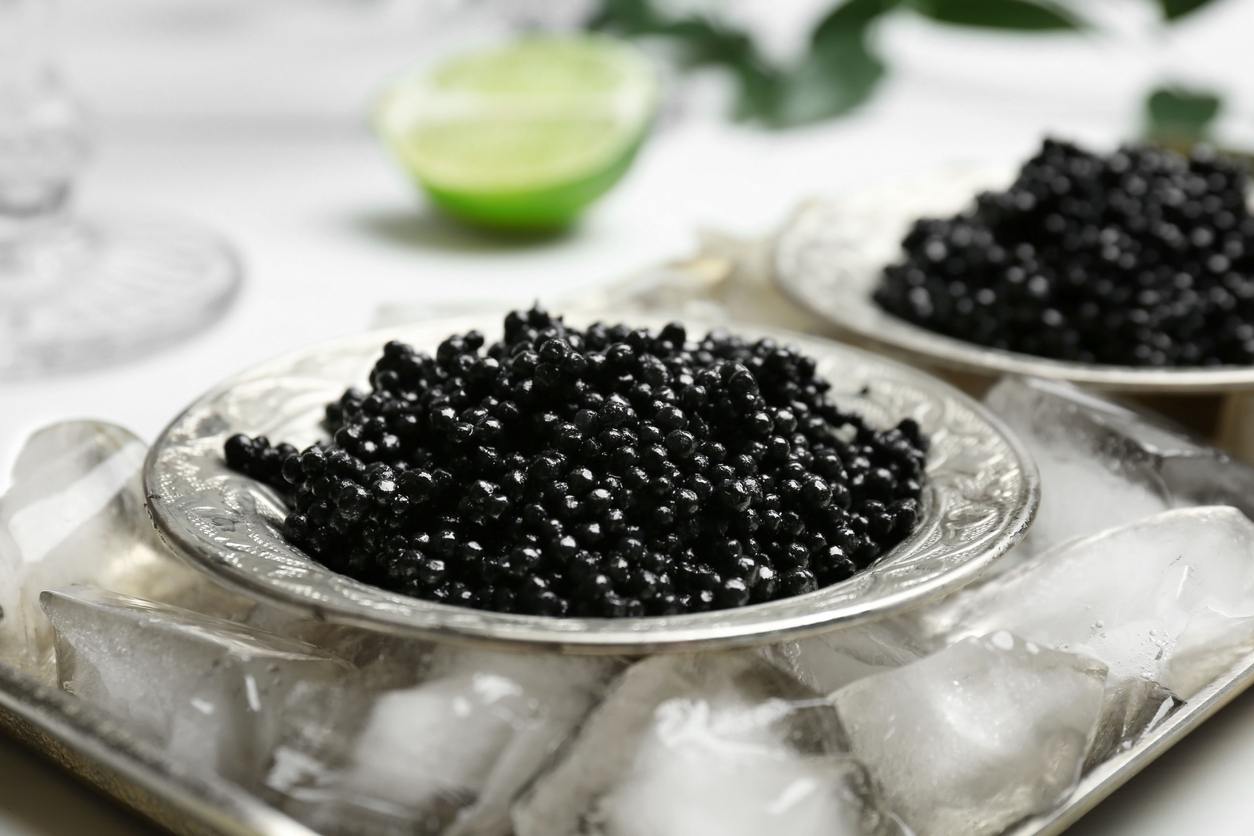When we in the West think of caviar, the image that usually comes to mind is one of unbridled luxury, lots of white table linens and maybe a complimentary French waiter complete with white gloves and tiny golden spoons for eating your equally tiny eggs. On the other hand, you may not picture luxury at all; instead, it might be a hellscape of strange, fishy snacks that have absolutely no business being so gosh-darn expensive. Yes, caviar can be quite the luxury item, and yes, caviar is also kind of a weird concept for our Western sensibilities to comprehend, but there’s so much more to caviar than what meets the eye.
First, let’s unpack the term “caviar”: derived from the Turkish khavyar, Webster’s dictionary defines caviar as “the processed, salted roe of a large fish (such as sturgeon)”, and while that may be a deceptively simple way to phrase it, it’s essentially true. Caviar is the eggs or roe of the sturgeon fish, preferably from either the Caspian or Black Seas, which are removed and preserved with salt. Traditionally, caviar was the exclusive business of Russia and the Middle East, but in the early 1900’s, U.S. sturgeon began making a splash on the caviar scene; in fact, thanks to some creative liberties taken with labeling, most of the caviar being billed as more expensive Russian caviar was actually U.S. caviar in disguise. At one point, the caviar craze reached such a peak that sturgeon, and particularly the highly prized Beluga sturgeon, were nearly fished to extinction, forcing caviar lovers to look elsewhere for their briny fix and driving up the price to luxury-status.

Raw caviar being processed.
Fish roe itself can be harvested from any number of fish and as a food in general goes back almost as far as human history itself, with the sturgeon having been a part of Middle Eastern and Eastern European diets since society developed. From Alaska to the Andes, almost every indigenous culture has included fish roe on their list of delicacies at some point! Roe can be harvested from both male and female fish, though true roe or “hard” roe can only come from female fish. While it varies slightly from species to species, fish roe is notable for being incredibly nutritious, so much so that it’s been called one of the original superfoods. Like all fish and fish byproducts, roe is rich in Omega-3 fatty acids which help with everything from heart health to memory and joint health; additionally, roe is packed chockablock full of vital nutrients like Vitamin D, Vitamin B12, magnesium, iron, a little calcium, and even something called selenium, a micronutrient which can only be found in similar quantities in Brazil nuts. As a result, fish roe is often traditionally associated with fertility and virility, and it makes sense – if you’re trying to make a new person, the nutrients packed into fish roe will certainly help! There are also traditional associations with everything from royalty to war, proving that no mater where or when, people have always been aware of the power of the fish egg.
Choosing Caviar

Flying Fish roe (Tobiko) and traditional black caviar.
Today, our notions of what is commercially considered caviar have expanded slightly, and the price range has expanded to match; nevertheless, the world of caviar is a complicated one, and there’s some necessary terminology and categorization to consider when preparing to take the plunge. First off, while the range of roe treated like caviar has expanded over the years, true caviar is still sourced exclusively from sturgeon. There are four different species of sturgeon, though overfishing means you can only buy caviar from three of them: The Beluga, the Osetra, the Sevruga, and the Sterlet. Sterlet caviar was once prized above all others for its pale, golden color and subtle flavor, but massive overfishing has driven the Sterlet nearly to extinction, resulting in a flat-out ban on Sterlet fishing. Beluga, the second highest prized sturgeon, is unfortunately well on its way to joining the Sterlet as a seriously endangered species, which has led to Beluga caviar no longer being available outside of Russia, and what is available is Expensive with a capital “E”. Osetra swims into third place and is known for having an almost nutty flavor, while Sevruga is in fourth with the smallest eggs and a tendency towards a stronger, saltier flavor.
Beyond true caviar, there is a multitude of high-quality fish roe on the market, much of which is far less expensive than their pricier counterparts. The first such high-quality roe is lumpfish caviar, which first came into fashion due to the overfishing of sturgeon populations in the early 1900’s and is considered a delicious and inexpensive alternative. In the U.S., whitefish and paddlefish caviar are also popular. The whitefish produces small, golden roe with a clean flavor that lends itself to cooking, while the paddlefish produces gray to brown roe with a distinct earthiness. Flying Fish roe are the small, orange eggs that often top sushi, and while their appearance may be pretty far from the typical sturgeon caviar we’re used to, they are actually fairly close in flavor to high quality sturgeon roe and make a fantastic substitute. With so many options, it’s easy to find a caviar that suits your tastes and budget.
Though choosing what kind of fish roe you want is important, it’s not the only piece of information you need to know. Caviar is graded on a scale that takes into account the roe beads’ size, flavor, texture, color, and finish; unfortunately, this practice is hardly standard, so trying to compare grade categories across brands can be difficult. Fortunately, though each brand may call their grades different names, they tend to follow a similar breakdown:
- Grade 1 – Highest grade, features large sized, whole beads with a firm texture, good color, and nuanced finish.
- Grade 2 – The flavor is still good, but the texture is less firm, and the beads may not be entirely intact.
This is a good, general rule of thumb to consider when choosing caviar, as brands will often give their own names to the categories of grades that they use. These are frequently something like Classic, Estate, Reserve, Royal, Imperial, and so on; generally, the fancier and more important the grade sounds, the higher quality the caviar. In America, you may also see grades 0, 00, and 000, with 000 being the highest quality caviar 0 being the lowest.
There are also two final caviar terms to consider that are, thankfully, used across the board: malossol meaning “little salt” and payusnaya meaning “pressed”. Malossol caviar has been treated with very little salt which, despite increasing the perishability, makes for a flavor that is superior to saltier caviar. Payusnaya caviar, meanwhile, is the result of the sieving process through which caviar passes as it is being prepared. Damaged eggs are not thrown out; instead, they are given the label payusnaya and sold as a mix of different roe. While it may not hold a candle to the good stuff, payusnaya caviar has an intense ocean flavor that makes it excellent for use in cooking and is generally inexpensive enough to be accessible to the home cook.
Serving Caviar
Here’s where the hoity-toity, high-lux business usually comes in, but to be honest, there’s just no escaping the fact that serving caviar is an art unto itself. Caviar is extremely delicate, both in flavor-profile and in general, and maintaining the integrity of the caviar from the time it’s opened to the moment you eat it takes a little preparation.
First off, the whole service must be ice cold, truly ice cold. Caviar won’t actually freeze until it reaches a good four or five degrees below the normal freezing temperature for water, meaning it can and should be kept in the coldest part of your refrigerator until you need it. Though caviar can be pasteurized to give it a slightly longer shelf life, it is nonetheless extremely perishable and prone to degradation; keeping caviar ice cold protects this valuable treat from spoiling before you get to eat it, though be careful not to let it actually freeze as it will ruin the texture. Whether you serve the caviar in its original tin or in a non-metal serving dish, it should always remain on ice, and any leftovers should be sealed as tightly as possible in their original tin and placed in the coldest part of the fridge to be eaten within one or two days.
On the subject of metal, remember the French waiter and his tiny golden caviar spoons? Yeah, he’s going to ruin your caviar. The membranes of the roe are extremely thin and permeable, meaning that they will absorb the flavor of whatever vessel they are put in or handled with – metal they come in contact with will impart a metallic flavor to the caviar, be it the dish they’re served in or the spoon they’re served with. Traditional caviar spoons tend towards the extravagant when it comes to their materials, maybe to make up for the fact that they can’t be made of gold or silver. Bone, mother of pearl, and even ivory have been used historically to make caviar spoons, and while ivory is certainly not recommended or available today, bone and mother of pearl spoons are still on the market for those who want to look. It is often served on plates made of mother of pearl and more often than that on simple cleaned shells. This is partially to preserve the integrity of the caviar, but there is also just something poetic about serving a delicacy like caviar on a natural work of art also from the ocean.
The last step in proper caviar serving protocol are the drinks. Caviar is salty; it’s so salty that, during its heyday in the early 1900’s, caviar would often be served as bar snacks to encourage patrons to drink more. You need something to wash away not only the salt but also the leftover coating good caviar leaves in the mouth – a drink acts as a palate cleanser, not just a thirst-quencher. In the West, we would usually pick Champagne as the natural accompaniment to such a gourmet dish, but unless you go for a really dry champagne, it usually isn’t strong enough to cut through the intense butteriness inherent in caviar. Instead, consider going with the more traditional vodka pairing. Now a little disclaimer: there’s vodka you get in a two-dollar plastic bottle at the gas station, and then there’s vodka. High quality vodka is clean in flavor and smooth on the finish, and the high alcohol content is perfect for cutting through all the briny, fatty goodness of caviar. If you’re really all about that bottle of bubbly, pick one with no added sugar or as little added sugar as possible.
Eating Etiquette
Caviar is meant to be the star of the show, so it’s best to keep it simple. Traditional caviar preparations involve buckwheat blini, a particular kind of tiny Russian pancake. Blini are not only cute, but they make a very effective method of transporting caviar to your mouth. Purists believe that straight-up is the only way to truly appreciate the flavor of good caviar, but that’s not a hard and fast rule. Caviar will often be served with little dollops of crème fraiche or sour cream, buttered toast points in place of blini, chopped boiled eggs, steamed potatoes, and thinly sliced green onion. While straight-up might be good for the extremely high-quality stuff, lesser quality caviar may actually benefit from having some other flavors to support it.

Black Caviar and Blini service.
As you may have already realized, caviar is somewhat of a food institution, and as such there is established proper and improper eating protocol. For instance, it considered extremely gauche among caviar aficionados to take more than your fair share of caviar, even if it is extremely tempting. The typical serving allotted to an individual is one to two ounces each, and a host usually will purchase their caviar with this kind of serving size in mind. Caviar is, ultimately, a luxury product and can be quite expensive, depending on the grade and the fish it came from. If you’re consuming the caviar in a private home, understand that your host may have spent a great deal of money procuring the caviar and that it is meant to be shared among everyone at the event; consuming caviar in restaurant can be even more expensive, making it more important still to not take more than your fair share. Obviously, close friends may not care quite as much about who gets how much caviar, but in fine-dining and formal social situations, self-control is key.
Another somewhat odd eccentricity of caviar eating customs is the way you actually eat it. Yes, there is actually a correct caviar eating technique too! First, take in the aroma of the caviar. Like a good wine, half of the flavor of the caviar is in the aroma; to taste the full bouquet of flavors, you must first get the scent in your nose. Next, unless you’re eating the caviar on a blini or toast point, turn the spoon over in your mouth so that all the caviar beads can be transferred to your tongue. Breathe in a little through your mouth too, also like you might do with a wine; this helps to capture the full aroma and flavor of the caviar on the palate. One must never chew the caviar, as this ruins the integrity of the beads and completely squashes the flavor; instead, allow the beads to spread over your tongue to coat your mouth and capture the full flavor of the caviar. Finally, don’t go straight for your drink after you swallow. The flavors of caviar continue to develop even after it’s no longer in your mouth, so sipping too soon after swallowing will result in missing the final notes of flavor. Give yourself a few seconds, then sip your vodka or Champagne.
So, there you have it: everything you never knew you needed to know about caviar, from sea to spoon! This week, put that newfound knowledge to the test: Stop by the Oliver’s Gourmet Cheese counter where our talented team can assist you. Make your New Year’s celebration — or any special occasion — a little more elegant and special with caviar!


No comments yet. Add the first comment